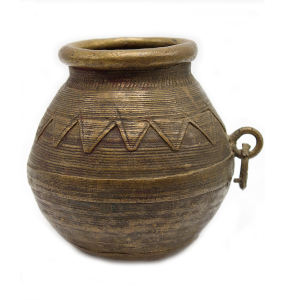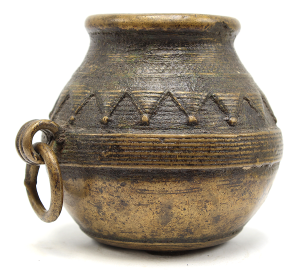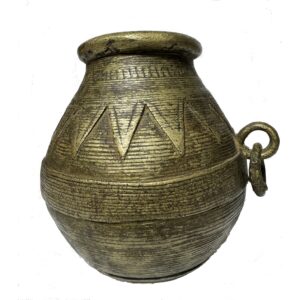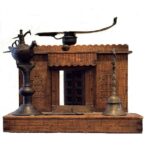Dhokra Metal Smiths: Retaining Primitive Techniques with Unfailing Success
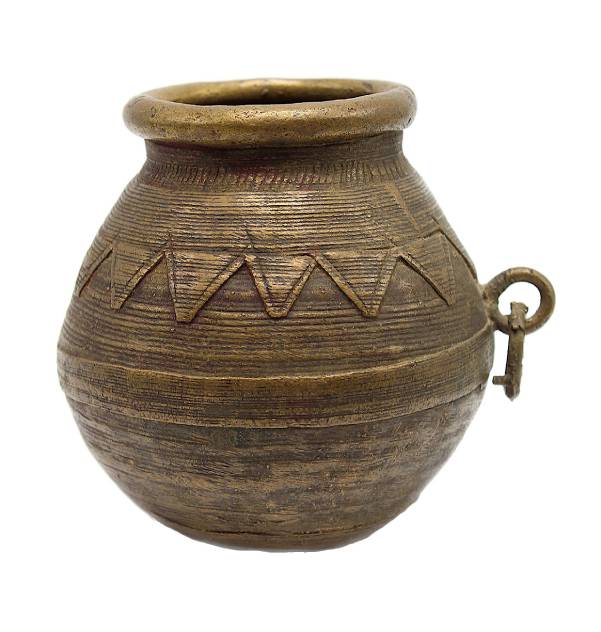
Antique brass vessels, figures, and religious objects have long been the specialty of Dhokra (Dokra) tribal metal smiths from Eastern India. The Dhokra are a nomadic group that over several millennia settled in different sections of Indian provinces and ended in tight knit communities in Orissa (now called Odisha), West Bengal ,and Eastern India. They continue to this day to use the same primitive art of metal craft based on the lost wax technique of metal casting that was used in India by the Indus Valley civilization almost 4500 years ago. Their identification with this primitive technique has resulting in the name Dhokra being used generically for “a variety of beautifully shaped and decorated brassware products created by the cire perdue or “lost wax” process. (Smith and Kochhar)
The long and labor intensive lost wax process comprised of several steps, and starts with creating a clay core that is slightly smaller then the ultimate desired artifact. The core is dried in the sun or burnt and then coated with a layer of beeswax mixed with a small amount of oil to the thickness of the desired artifact to create a mold. The mold is coated with another thin layer of clay that is intricately imprinted with design elements. After the clay dries, additional clay layers are added to the mold to make it harder and thicker. The completed mold is heated and the wax is melted and extracted, resulting in a mold with a cavity and one or more channels. Molten metal is poured though the channels to fill the cavity that form the shape of the finished artifact. The mold is allowed to dry and is then fired in an oven. After cooling, the clay mold is broken to release the cast metal object that is cleaned and then details are carved or incised to complete the piece. As stated by Bhattacharya, “These simple steps are being followed since the very primitive age with unfailing success for generating … rare and precious art pieces.”
Displaying simplicity, a strong folk style, and decorated with delightful traditional motifs, Dhokra pieces include figurative objects such horses, elephants, peacocks and other animals; utilitarian items such as grain/rice measuring bowls, chains, and lamps; and religious images of deities like Durga, Laxmi, Saraswati, Krishna, Shiva, and Ganesh. Hindu society has close ties to the Dhokra community as their religious images are highly sought after for home worship (puja) and for many religious festivals. Newly married Hindu couples installed these images to bring prosperity an happiness to their homes. The measuring bowls of different sizes were regarded as symbols of the goddess Lakshmi and were greatly prized by local villagers who could afford them. (Smith and Kochhar) In Hinduism rice plants which are about to be harvested represent the Lakshmi, the Hindu Goddess of wealth, prosperity and fertility. Dhokra items are beautifully and often intricately decorated, very accessible, made with an appealing simplicity, and their uncomplicated forms are forceful and captivating. Being made with the lost wax technique each item has a unique and distinct identity as a unique one-of-a-kind piece of art.
Items produced by Dhokra tribal artisans, especially antique pieces, are in great demand domestically and internationally, and are, consequently, are very collectable yet still affordable. Unfortunately, like most authentic ethnographic art and artifacts, there is a scarcity of genuine antique and vintage pieces available and the craft and techniques used to create new ones have been declining for many years. Most Dhokra communities struggle with poverty, and many families are leaving the craft to survive. The rising price of raw materials and subsequent high prices for end products are making them less affordable to their natural local market and their primitive techniques result in slow production times. Meanwhile, changing tastes and contemporary preferences for more modern designs are difficult for conservative yet brilliant artisans to respond to, and the lack of government intervention to assist them makes preservation of this age old tradition tenuous. As stated in a 1994 study, “Perhaps the poorest craft group of West Bengal, the Dhokras are the most interesting and creative. In recent years, under the pressure of all-embracing industrialization and changing social values, they have been forced by the loss of their natural rural market to diversify their products and are now seeking, with the help of the government and some voluntary agencies, a market among urban sophisticates, as creators of decorative ware.”
Despite these difficult conditions, however, there is a new emerging global market in the United States, the UK, Italy, and Paris for these unique Dhokra items that can be a boon for these struggling metal smiths and an incentive to maintain their millennial old traditions.
Sources
Sourish Bhattacharya, “Dhokra Art and Artifacts of Bikna: Problems and Prospects,”
Champak Kumar, “Traditional Knowledge on Dhokra Craft of Mayurbhanj”, International Journal of Conservation Science. Apr/Jun2015, Vol. 6 Issue 2, p 217-222.
David Smith and Rajesh Kochhar, “The Dhokra Artisans of Bankura and Dariapur, West Bengal: A Case Study and Knowledge Archive of Technological Change in Progress,”

